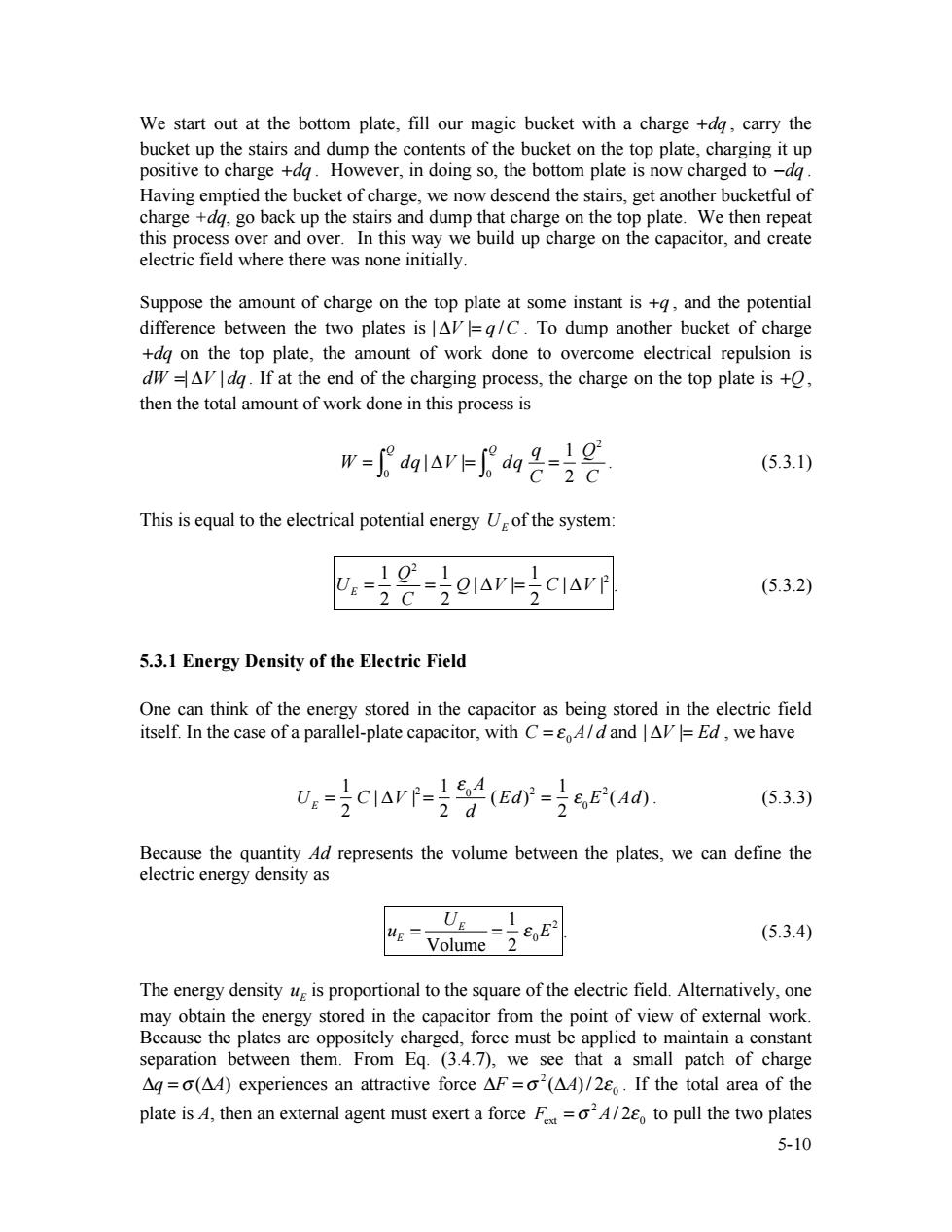正在加载图片...

We start out at the bottom plate,fill our magic bucket with a charge +dg,carry the bucket up the stairs and dump the contents of the bucket on the top plate,charging it up positive to charge +dg.However,in doing so,the bottom plate is now charged to -dg. Having emptied the bucket of charge,we now descend the stairs,get another bucketful of charge +dg,go back up the stairs and dump that charge on the top plate.We then repeat this process over and over.In this way we build up charge on the capacitor,and create electric field where there was none initially. Suppose the amount of charge on the top plate at some instant is +g,and the potential difference between the two plates is Al=g/C.To dump another bucket of charge +dg on the top plate,the amount of work done to overcome electrical repulsion is dw=AVdg.If at the end of the charging process,the charge on the top plate is + then the total amount of work done in this process is m-1ar=是-是 (5.3.1) This is equal to the electrical potential energy Ue of the system: U,-1-QIAYHCIAPP 2C2 (5.3.2) 5.3.1 Energy Density of the Electric Field One can think of the energy stored in the capacitor as being stored in the electric field itself.In the case of a parallel-plate capacitor,with C=4/d and AV =Ed,we have U.CIAP() (5.3.3) Because the quantity Ad represents the volume between the plates,we can define the electric energy density as u E UE= (5.3.4) Volume 2 The energy density u is proportional to the square of the electric field.Alternatively,one may obtain the energy stored in the capacitor from the point of view of external work. Because the plates are oppositely charged,force must be applied to maintain a constant separation between them.From Eq.(3.4.7),we see that a small patch of charge Ag=(A4)experiences an attractive force AF=(AA)/2.If the total area of the plate is A,then an external agent must exert a force F=2A/2 to pull the two plates 5-105-10 We start out at the bottom plate, fill our magic bucket with a charge +dq , carry the bucket up the stairs and dump the contents of the bucket on the top plate, charging it up positive to charge +dq . However, in doing so, the bottom plate is now charged to !dq . Having emptied the bucket of charge, we now descend the stairs, get another bucketful of charge +dq, go back up the stairs and dump that charge on the top plate. We then repeat this process over and over. In this way we build up charge on the capacitor, and create electric field where there was none initially. Suppose the amount of charge on the top plate at some instant is +q , and the potential difference between the two plates is | !V |= q /C . To dump another bucket of charge +dq on the top plate, the amount of work done to overcome electrical repulsion is dW =| !V | dq . If at the end of the charging process, the charge on the top plate is +Q , then the total amount of work done in this process is 2 0 0 1 | | 2 Q Q q Q W dq V dq C C = ! = = " " . (5.3.1) This is equal to the electrical potential energy UE of the system: 2 1 1 1 2 | | | | 2 2 2 E Q U Q V C V C = = ! = ! . (5.3.2) 5.3.1 Energy Density of the Electric Field One can think of the energy stored in the capacitor as being stored in the electric field itself. In the case of a parallel-plate capacitor, with 0 C = ! A/ d and | !V |= Ed , we have UE = 1 2 C | !V | 2 = 1 2 " 0A d (Ed) 2 = 1 2 " 0E2 (Ad) . (5.3.3) Because the quantity Ad represents the volume between the plates, we can define the electric energy density as 2 0 1 Volume 2 E E U u = = ! E . (5.3.4) The energy density E u is proportional to the square of the electric field. Alternatively, one may obtain the energy stored in the capacitor from the point of view of external work. Because the plates are oppositely charged, force must be applied to maintain a constant separation between them. From Eq. (3.4.7), we see that a small patch of charge "q = ! ("A) experiences an attractive force 2 0 #F = ! (#A)/ 2" . If the total area of the plate is A, then an external agent must exert a force 2 ext 0 F = ! A/ 2" to pull the two plates